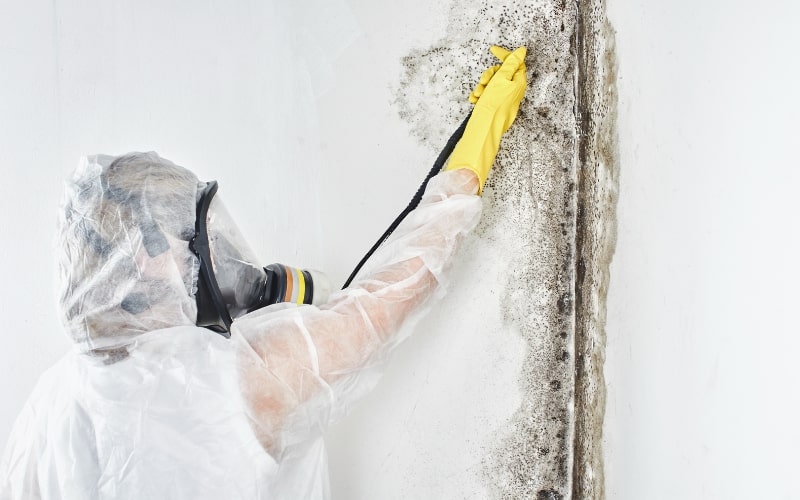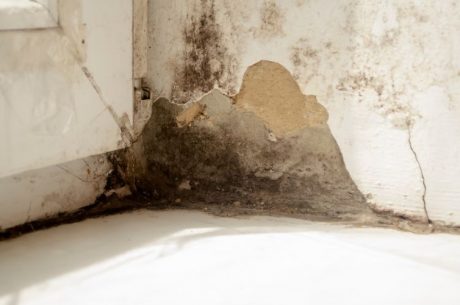Black mold in shower is a serious issue that shouldn’t be ignored. It thrives in damp, poorly ventilated spaces and can quickly spread, affecting both your bathroom and your health. This type of mold, often appearing as dark black or green patches, can cause respiratory problems, trigger allergies, and even damage surfaces over time. The constant moisture from showers creates the perfect environment for mold to grow, making it essential to address the problem immediately.
In this article, we’ll explore why black mold appears, why you should never ignore it, and the steps you can take to eliminate it. If the mold spreads or keeps coming back, it’s best to hire a professional mold remediation expert to ensure a thorough and safe cleanup.
What Is Black Mold in Shower, and Why Does It Appear?
Black mold in shower is a type of fungus, typically Stachybotrys chartarum, that grows in damp, warm, and poorly ventilated spaces. It appears as dark black or green patches on grout lines, tiles, or caulking. Showers naturally create a moist environment, which encourages mold growth, especially if water lingers or cleaning is infrequent. Soap scum, body oils, and shampoo residue also provide nourishment for mold spores. Poor air circulation and lack of sunlight make it easier for black mold to thrive and spread. If left untreated, it can damage surfaces and negatively impact indoor air quality and your health.
Why You Should Never Ignore Black Mold in Shower
Even if it starts small, black mold in your shower is not something you should overlook. It can multiply quickly and pose health and home hazards if not removed. Here are key reasons why prompt attention is essential:
- Health Risks – Breathing in mold spores can cause coughing, sneezing, headaches, or even trigger asthma and allergy symptoms.
- Surface Damage – Mold eats into grout, tile, and drywall, weakening structures and leading to costly repairs over time.
- Musty Odor – Black mold releases a persistent earthy smell that makes your bathroom feel unclean even when scrubbed.
- Widespread Contamination – If not addressed, mold can spread to ceilings, ventilation systems, or adjoining rooms.
- Rental or Property Issues – Tenants or landlords could face legal disputes if black mold is ignored and causes health or safety concerns.
Immediate Steps to Take When You Find Black Mold in Shower
Discovering black mold in your shower may be alarming, but quick action can prevent it from spreading and causing further damage. Here are five steps you should take right away to handle the situation effectively:
1. Increase Ventilation Immediately
Open bathroom windows and doors to allow fresh air in and moisture out. Run the exhaust fan or use a portable fan to help dry the area faster. Mold thrives in stagnant, humid conditions, so boosting airflow helps slow its growth. Avoid using the shower until everything is dry. If your bathroom tends to stay damp, consider adding a dehumidifier. Improving ventilation is a crucial first step, especially while preparing to clean or treat the mold-affected areas thoroughly and prevent it from coming back.
2. Wear Proper Protective Gear
Before tackling the mold, put on gloves, a mask, and safety goggles. Black mold releases spores that can irritate your skin, eyes, and lungs. Even a short cleaning session can expose you to potential health risks. Use clothing you don’t mind washing immediately or discarding. Taking these precautions keeps you safe and prevents spores from spreading to other areas of your home during cleanup. Always wash your hands and any exposed skin thoroughly after handling mold, and dispose of cleaning materials like sponges or rags properly.
3. Use an Effective Cleaning Solution
Clean affected surfaces with mold-killing agents like white vinegar, hydrogen peroxide, or commercial mold removers. Spray the solution on the moldy area and let it sit for 10–15 minutes. Then, scrub using a firm brush and rinse thoroughly. Be cautious not to mix cleaners like bleach and ammonia, as they can create dangerous fumes. Repeat if necessary, and dry the area completely afterward. This method works best for small, visible spots. Consistent cleaning and drying can prevent mold from returning and keep your shower sanitary and safe.
4. Remove and Replace Moldy Grout or Caulk
If mold has deeply penetrated caulk or grout, cleaning may not be enough. Scrape away the old, mold-infested material with a utility knife or grout remover. Apply fresh, mold-resistant caulk or grout to seal the area again. This ensures mold spores trapped beneath the surface are fully removed. Dispose of contaminated materials in a sealed bag to avoid spreading spores. Let everything dry thoroughly before using the shower again. This step offers long-term protection and restores the appearance and cleanliness of your bathroom.
5. Call a Mold Remediation Professional
If the mold covers more than a small patch or keeps coming back, it’s best to call a certified mold remediation specialist. These professionals use specialized tools and treatments to safely remove mold, identify hidden moisture sources, and prevent regrowth. They can inspect behind tiles or walls where mold often hides. Hiring an expert ensures the job is done thoroughly, protecting both your home and your health. It’s especially important if the mold has affected ventilation systems or caused visible damage beyond the shower area.
Frequently Asked Questions

Image by amixstudio from Getty Images on Canva
Can black mold in shower affect other rooms in my home?
Yes, black mold in shower can spread to other rooms if spores travel through the air or ventilation systems. If moisture and organic materials are present elsewhere, mold can colonize new areas. Promptly addressing mold in the bathroom and improving overall ventilation throughout your home are key steps to keeping it from spreading beyond the shower.
How long does it take for black mold to grow in a shower?
Black mold can start to appear in as little as 24 to 48 hours in damp, humid environments. Showers are ideal for mold growth due to the constant moisture from water usage. However, mold growth can become noticeable after several days or even weeks, depending on ventilation, humidity levels, and frequency of cleaning. Prompt action helps prevent further spread.
How can I tell if the mold in my shower is black mold?
Black mold typically appears as dark green or black patches. It can be slimy or fuzzy in texture, often found in damp areas like grout lines, caulk, or tiles. If you’re unsure, you can contact a mold inspector or use a mold test kit, but it’s best to treat it as black mold if it’s in a consistently moist area.
Conclusion
Black mold in shower should never be ignored due to the health risks and potential property damage it can cause. Taking immediate action to clean and address the problem can prevent further harm. If mold persists or spreads, it’s essential to consult a professional for thorough remediation.
If you’re dealing with black mold in your shower, PuroClean Zephyrhills is here to help. Our expert team offers comprehensive mold remediation services to restore your bathroom’s safety and cleanliness. Contact us today for a professional mold inspection and effective solutions!




 PuroClean Certified Restoration Specialists
PuroClean Certified Restoration Specialists